Frank Miles Day
Frank Miles Day (April 5, 1861 – June 15, 1918) was a Philadelphia-based architect who specialized in residences and academic buildings.
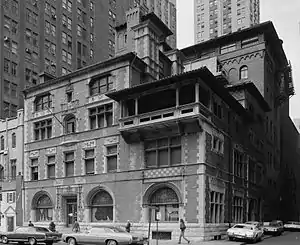
Career
In 1883, he graduated from the Towne School of the University of Pennsylvania, and traveled to Europe. In England, he apprenticed under two architects, and won the 1885 prize from the Architectural Association of London. He returned to Philadelphia, and worked in the offices of George T. Pearson and Addison Hutton, before opening his own office in 1887. Day's first major commission was the Art Club of Philadelphia (1889–90, demolished 1975-76), on South Broad Street in Center City, Philadelphia. His brother Henry joined the firm in 1893 (Frank Miles Day & Brother), and Charles Zeller Klauder, who had been his chief draftsman since 1900, became a partner in 1911 (Day Brothers & Klauder). From 1912 to 1927, even after Day's 1918 death, the firm was known as Day & Klauder.
Day was a lecturer in architecture at the University of Pennsylvania and Harvard University, and taught perspective at the Pennsylvania Academy of the Fine Arts. He was supervising architect for Yale University and Johns Hopkins University, and supervising or executive architect for Pennsylvania State College (now University), New York University, Delaware College (now University of Delaware), and the University of Colorado.[1]
Day made major additions to the campuses of the University of Pennsylvania, Pennsylvania State University and Wellesley College. Day & Klauder designed 18 buildings for Princeton University, although half were Klauder's work, completed after Day's death.[2] Day's 1917 master plan for the University of Delaware was inspired by Thomas Jefferson's plan for the University of Virginia.[3] Following the firm's 1917 master plan for the Boulder campus, Klauder went on to design much of the University of Colorado.
Day was national president of the American Institute of Architects, 1906–07; a founding editor of House & Garden Magazine; and author of a number of books, including American Country Houses of Today (1915). In 1910, he was elected into the National Academy of Design as an Associate Academician.
Day is interred at West Laurel Hill Cemetery in Bala Cynwyd, Pennsylvania.

Day designed the 2nd Franklin Field (1903, demolished 1922), shown above, and Weightman Hall ("The Fieldhouse") (1903-04), visible in the upper left. The current stadium was designed in 1922 by Day's partner, Charles Zeller Klauder, who also added its upper deck in 1925.
Selected works
Philadelphia buildings
- Edward Wood houses, 245-47 S. 17th St. (1888–90)[4] Now the Black Sheep Pub.
- Art Club of Philadelphia, 220 S. Broad St. (1889–90, demolished 1975–76)
- Alterations to Tenth Presbyterian Church, 1700–08 Spruce St. (1893)[5]
- New Horticultural Hall, 250 S. Broad St. (1894–96, demolished 1917)[6]
- American Baptist Publication Society, 1420-22 Chestnut St. (1896–97).
- C. B. Newbold residence, 1313 Locust St. (1897)[7]
- "Cogslea" (Violet Oakley residence & studio), 615 St. Georges Rd., Mount Airy (1902).
- Philadelphia Art Alliance (Samuel P. Wetherill mansion), 251 S. 18th St. (1906)[8]
- Vernon Park Branch, Free Library of Philadelphia, 5708 Germantown Ave., Germantown (1906)[9]
- Second Church of Christian Scientist, 5443 Greene St., Germantown (1918–25), (now Taulane Assembly Building, Germantown Friends School)
University of Pennsylvania
- Houston Hall, 3417 Spruce St., University of Pennsylvania, designed with William C. Hays and Milton D. Medary (1894)
- Pedestal of Benjamin Franklin Statue, John J. Boyle, sculptor, College Hall, 3420 Locust Walk, University of Pennsylvania (1896–99). Moved from 9th & Chestnut Sts., 1939.
- University of Pennsylvania Museum, 3260 South St., University of Pennsylvania, designed with Wilson Eyre and Cope & Stewardson (1899)
- Franklin Field (2nd stadium), 33rd & Spruce Sts., University of Pennsylvania (1903, demolished 1922). The current Franklin Field is the 3rd stadium on the site, designed in 1922 by Day's partner, Charles Zeller Klauder, with the upper deck (also by Klauder) added in 1925.
- Weightman Hall ("The Fieldhouse"), 233-35 S. 33rd St., University of Pennsylvania (1903–04)
Princeton University
- Holder Hall Quadrangle, Princeton University, (1909)
- Memorial Tower, Princeton University, (1911)
- Hamilton Hall, Princeton University, (1911)
- Princeton University Clubhouse, Princeton University, (1911)
- Cuyler Hall Dormitories, Princeton University, (1913)
- Princeton Hall (Quadrangle Club), Princeton University, (1913)
- Madison Hall Dining Complex ("The Commons"), Princeton University, (1916)
- Sage Hall Dormitories, Princeton University, (1916)
- Pyne Hall and Gymnasium, Princeton University, (1922)
The Pennsylvania State University
- Stock Pavilion, Pennsylvania State College, State College, Pennsylvania (1913)
- Liberal Arts Buildings, Pennsylvania State College, State College, Pennsylvania (1913–37)
- Chemical Building, Pennsylvania State College, State College, Pennsylvania (1914)
- Dairy & Creamery Building, Pennsylvania State College, State College, Pennsylvania (1914)
- Mining Building, Pennsylvania State College, State College, Pennsylvania (1915, demolished)
University of Delaware
- Harter Hall Dormitories, Delaware College, Newark, Delaware (1916)
- Wolf Hall Science Building, Delaware College, Newark, Delaware (1917)
- Sussex Hall Dormitories, Delaware College, Newark, Delaware (1917)
- Sigma Phi Epsilon fraternity, Delaware College, Newark, Delaware (1919)
Buildings Elsewhere
- Madison Public Library (Carnegie Library), 1249 Williamson St., Madison, Wisconsin (1904–06), now Grieg Chorus Club.
- Tuberculosis Hospital, 4600 Arkansas Ave. NW, Washington, D.C. (1908, demolished)[10]
- Parish House & Rectory, Trinity Episcopal Church, Wilmington, Delaware (1909–10)[11]
- Gymnasium, Mercersburg Academy, Mercersburg, Pennsylvania (1911)
- Dormitories, Mercersburg Academy, Mercersburg, Pennsylvania (1912)
- New Haven Hospital, New Haven, Connecticut (1912, expanded by Day & Klauder 1914-26)
- Dormitories, Cornell University, Ithaca, New York (1912–19)
- Textile Building, Rhode Island School of Design, Providence, Rhode Island (1914)
- Charlton Yarnall residence at Crum Creek Farm (1914) 2600 Wayland Road Berwyn, Pennsylvania (currently the offices of Melmark School) [12]
- Founders Hall, Wellesley College, Wellesley, Massachusetts (1915)[13]
- Sigma Phi Fraternity, Cornell University, Ithaca, New York (1915–16)[14]
- Hartford Theological Seminary, Hartford, Connecticut (1915–16)
- Lapham Field House, Yale University, New Haven, Connecticut (1917–23)
- McCormick Theological Seminary, Chicago (1918)
- J. L. Ketterlinus summer home, Bar Harbor, Maine (1896)
Gallery
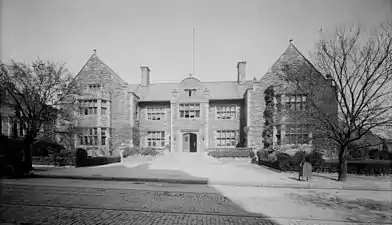 Houston Hall, University of Pennsylvania (1894). Designed with William C. Hays and Milton D. Medary.
Houston Hall, University of Pennsylvania (1894). Designed with William C. Hays and Milton D. Medary.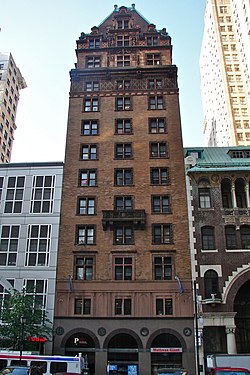 American Baptist Publication Society, Philadelphia (1896–97).
American Baptist Publication Society, Philadelphia (1896–97).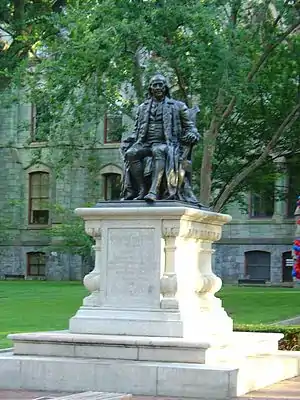 Pedestal, Benjamin Franklin Statue, John J. Boyle, sculptor, University of Pennsylvania (1896–99).
Pedestal, Benjamin Franklin Statue, John J. Boyle, sculptor, University of Pennsylvania (1896–99).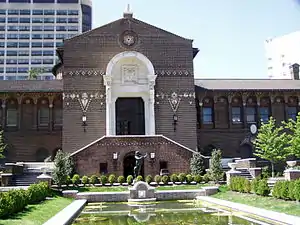 University of Pennsylvania Museum, Philadelphia (1899), designed with Wilson Eyre and Cope & Stewardson.
University of Pennsylvania Museum, Philadelphia (1899), designed with Wilson Eyre and Cope & Stewardson. "Cogslea" (Violet Oakley residence & studio), 615 St. Georges Rd., Philadelphia (1902).
"Cogslea" (Violet Oakley residence & studio), 615 St. Georges Rd., Philadelphia (1902).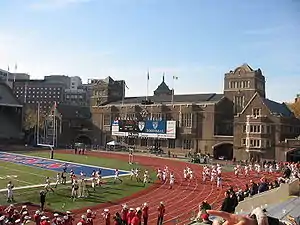 The Fieldhouse (Weightman Hall), Franklin Field, University of Pennsylvania (1903–04).
The Fieldhouse (Weightman Hall), Franklin Field, University of Pennsylvania (1903–04). Philadelphia Art Alliance (Samuel P. Wetherill mansion), Philadelphia (1906).
Philadelphia Art Alliance (Samuel P. Wetherill mansion), Philadelphia (1906). Holder Hall Quadrangle, Princeton University (1909).
Holder Hall Quadrangle, Princeton University (1909). Cuyler Hall Dormitories, Princeton University (1913).
Cuyler Hall Dormitories, Princeton University (1913).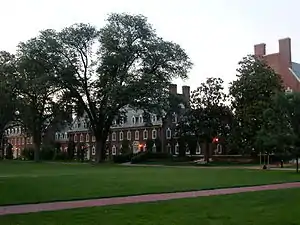 Harter Hall Dormitories, University of Delaware (1916).
Harter Hall Dormitories, University of Delaware (1916).
References
- New York Times obituary, June 18, 1918.
- Princeton Dormitories and Dining Halls
- University of Delaware Brief History
- Wood houses from St. Croix Architecture.
- "10th Presbyterian Church". Archived from the original on 2012-03-07. Retrieved 2009-07-18.
- New Horticultural Hall from Bryn Mawr College.
- Newbold residence from Bryn Mawr College.
- Philadelphia Art Alliance
- Vernon Park Library from Philadelphia Architects and Buildings.
- DC Tuberculosis Hospital photo, plans & description from Thomas Spees Carrington, Tuberculosis Hospital and Sanatorium Construction (National Tuberculosis Association, 1914), pp. 72-74.
- Trinity Episcopal Church
- Christopher Driscoll, Janice Elston, Newtown Square, Arcadia, 2009, p. 95
- "Founders Hall, Wellesley College". Archived from the original on 2009-07-05. Retrieved 2009-07-18.
- Sigma Phi from Philadelphia Architects and Buildings.
External links
- Frank Miles Day at Find a Grave
- Frank Miles Day at Architectural Archives, University of Pennsylvania
- Frank Miles Day at Philadelphia Architects and Buildings
- Frank Mead: 'A New Type of Architecture in the Southwest,' Part I, 1890-1906 for much on Day's early mentorship of Frank Mead and Charles Barton Keen.